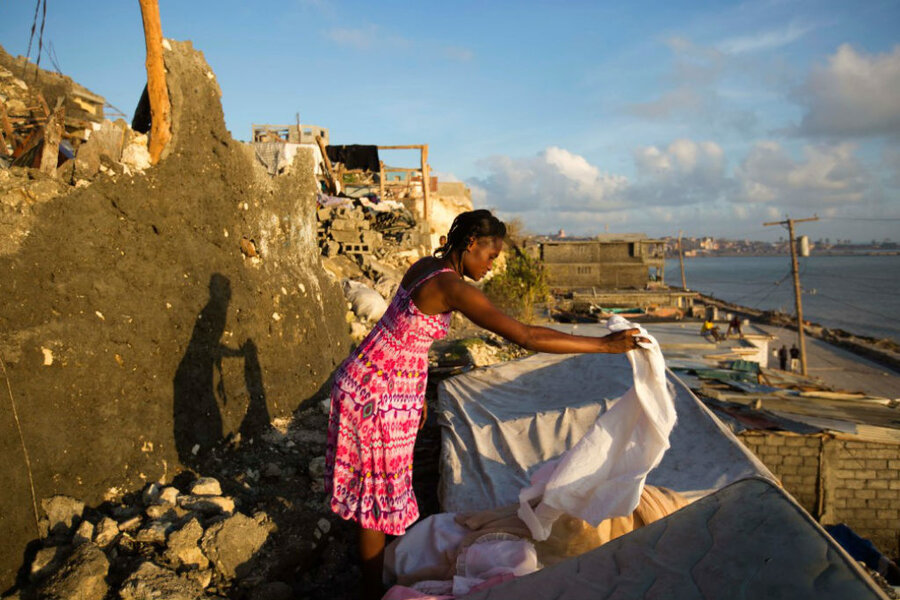Who’s helping Haiti in the wake of hurricane Matthew?
Days after hurricane Matthew hit Haiti, hundreds of thousands of people are looking for help and starting to rebuild their lives. Assistance is pouring in from abroad – and progress is already being made, officials say.
The hurricane is the “largest humanitarian event” to affect Haiti since the 2010 earthquake in Port-au-Prince, according to Mourad Wahba, the top UN official in Haiti. Recent estimates suggest that abut 900 people lost their lives. In addition, the hurricane destroyed thousands of homes and a bridge connecting the hard-hit south with the capital, Port-au-Prince.
Many people are unsure what the future looks like. Hunger and sanitation are particular concerns. But officials sound more optimistic about Haiti’s recovery prospects than they were after previous natural disasters.
“We are on the right track,” Yvonne Helle, Country Director for Haiti, tells The Christian Science Monitor in a phone interview. Both she and Haiti’s minister of planning are “so relieved” with the death toll numbers, she says. “We had expected it to be so much higher."
Since the 2010 earthquake, international organizations have helping to improve Haiti’s disaster preparedness and response. The UNDP has been working with Haiti’s Directorate of Civil Protection to develop a national disaster risk management system and support sustainable development.
That program is now having tangible effects, Ms. Helle says.
“We see that the impact is actually less than it could have been [without] simulation exercises [and other educational programs] that have allowed people to evacuate in time,” she explains. Better construction of buildings has also helped with these resilience efforts.
Support is flowing into Haiti from around the world.
The United States has dispatched nine helicopters to help with search-and-rescue efforts, including medical evacuations, and transporting supplies. Adm. Kurt Tidd told reporters at the Pentagon that the US also plans to deploy a “joint task force” of between 150 and 200 troops to Haiti.
The European Union sent a team of civil protection experts to the country and is offering shelters and safe drinking water to those in need. UNICEF positioned emergency supplies in the country ahead of the hurricane.
Online collections are channeling funds to programs in the region. Even a Florida museum got involved in its own small way: Pérez Art Museum Miami is offering free admission to visitors, who are encouraged to write postcards to people in Haiti or bring canned goods to donate.
“The museum is a site for people to connect and inspire each other, so our hope is that PAMM Postcards engages our community to connect with those in need through artistic messages of support and encouragement,” PAMM director Franklin Sirmans told NBC Miami, explaining that Miami’s proximity to the Caribbean made the events particularly salient.
In Haiti, an Oxfam “crisis cell” program sent groups of volunteers into rural towns in northern Haiti to advise people on storm preparation. Others are using social media to connect those in need of help with those that can provide it.
The efforts are another sign of lessons learned from the 2010 earthquake, as the Monitor's Laurent Belsie reported on Wednesday:
In the aftermath of the 2010 earthquake, for example, volunteers at Tufts University’s Fletcher School combined crisis-mapping software called Ushahidi with social media posts and media reports to alert aid organizations to areas needing the most help. In one dramatic instance, a text from two women and a 7-year-old alerted a US rescue team, which pulled them from the rubble of a collapsed supermarket.
Now, six years later, Haitians themselves – specifically, the Rotary Club of Port-au-Prince’s ritzy suburb, Petionville – are using the software to track reports of need.
Helle says local NGOs have been important to relief efforts by “providing data and information.”
What’s next for Haiti? Roads are being cleared and people are already getting back to work. The UNDP hopes cash-for-work schemes will help “communities to get back on their feet as quickly as possible.” It’s about giving people back their dignity, Helle explains.
Food security has been a particular concern. A million Haitians were already affected before the hurricane hit. Marc Soniel Noel, deputy mayor of the town of Chantal in the hardest-hit area of the country, told CNN that he doesn’t know how to combat the loss of crops. Bananas, avocados, and mangos have all been heavily affected.
“We have nothing left to survive on,” he said. “All the crops have gone. All fruit trees are down. I don’t have a clue how this is going to be fixed.”
Quite a lot of Haiti’s food is already imported, Helle tells the Monitor, and food is being trucked in from the Dominican Republic to help cover the shortfall. In the long term, the plan is “early recovery,” which aims to make sure that households can begin replanting soon, ideally within the next six months.
It’s important to keep attention on these issues in order to continue to make progress, Helle emphasizes. She hopes donors will continue to fund projects in Haiti after the immediate humanitarian response dies down.
While the high winds and heavy rainfall “would also have impacted very developed countries,” she says, “there are certain things you can do … and we will need a concerted effort over the coming 15 years to build better, to build more sustainably.”
For those who want to donate, Charity Navigator has a page that lists charities working in Haiti and offers a rating system to assess their effectiveness.






